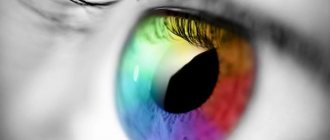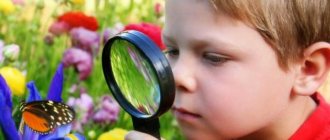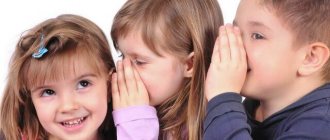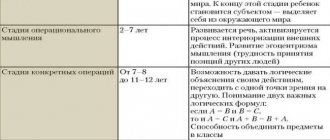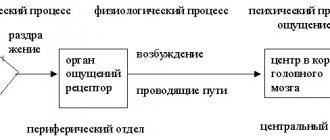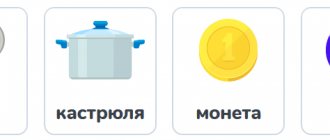Human mental activity is extremely multifaceted, because each of us has to solve a wide variety of problems every day. This feature of thinking allows us to distinguish its types: objective-actional, visual-figurative and verbal-logical, which begin to develop in preschool age. That is why it is necessary to provide conditions for the full development of the child’s thinking. First of all, imaginative thinking deserves attention, as it is predominant among preschoolers and primary schoolchildren. Success in mastering kindergarten and school programs largely depends on it. Psychologists have proven that preschool children’s intelligence is formed on the basis of imaginative thinking. It helps younger schoolchildren build a scientific picture of the world, develop an attentive attitude to surrounding objects, and develop the ability to see the beauty around them. All this develops creativity and imagination, influencing the choice of profession in the future. For example, this type of thinking is inherent in people of creative professions: artists, writers, designers, architects.
According to scientific definition, imaginative thinking is the ability to mentally imagine and reproduce the world around us in the form of images of objects and phenomena. Caring parents aimed at fully raising their baby should think about how to develop imaginative thinking?
Developmental tasks for preschoolers on logical thinking
If in early preschool age visual and figurative thinking is dominant, then older children on the threshold of schooling should rely on logic in their conclusions. It
is also important to justify all your decisions verbally. Therefore, this type of thinking has another name - verbal
Effective techniques that develop verbal logical thinking in older preschoolers include didactic games and exercises.
Association games
Verbal games for building an associative series are perceived with interest by preschoolers, as they are based on images. Children imagine what is behind the proposed concept and come up with words related to this concept.
1.Who will praise best? Children are asked to come up with as many characteristics as possible for one object. You can add a competitive nature to this game.
2. Identify the owner. Children are given one or two striking signs, on the basis of which they determine a holistic image.
- tail and ears
- pen
- spines
- sheet
- lid
3.Free associations. Instructions: “What image or sign do you remember when you hear this word?” Several people can take part in the game. The first names any word, the second names its association with it, the third names the quality or concept associated with the previous word. Sometimes you can clarify why exactly this association arose in a preschooler.
Logical reasoning exercises
1.Complete tasks using visual material. Children are offered pictures with images where they have to identify an extra object, pick up a missing one, or insert a missing figure into its place.
The preschooler not only finds a solution, but also explains his choice and verbalizes his reasoning.
2. Tricky lotto. Prepare two identical sets of pictures. Children play in pairs, each participant receives their own set.
One of the participants chooses one picture at his discretion and, without showing it, describes the image, highlighting the main features. The second participant guesses and then offers his description of another picture.
3. Guess it! Participation of four or more children is desirable. Preschoolers form two subgroups. One of them agrees on what object to wish for. Participants in the second subgroup, in order to guess the object, ask questions that can only be answered in monosyllables - “yes” or “no.”
The task is not only to guess, but also to be able to identify important signs. Having received the answer, the subgroups change roles.
Games for the development of conceptual apparatus
1. Help out the alien. Children really love this game, in which it is assumed that they have met an inhabitant of another planet who knows nothing about our world. Typically, one child plays the role of an alien and asks questions:
- What is this?
- What is this item for?
- How to use it?
One or two preschoolers answer questions from an inquisitive guest. The game well develops verbal logical thinking, as well as coherent speech.
2. Does this happen or not? Instructions: “Make a true and false judgment using the given words.” Prepare a few pairs of words for the game.
For example, a tree - roots. True proposition: “Every tree has roots.” False: “leaves grow on the roots of the tree.”
3. Because... Instructions: “Come up with at least three explanations for the same event (phenomenon, fact).” Example: The flowers bloomed because...
- …spring has come
- ...they were watered on time
- ...even the flowers wanted to please Masha
Such game exercises develop mental operations, the ability to establish cause-and-effect relationships, and the ability to formulate judgments and inferences.
Mental operations and their role in the development of thinking in preschoolers
Universal mental operations inherent in human thinking are analysis, synthesis, comparison, generalization and classification. It is the ability to use these operations that determines the development of thinking in preschool children.
Comparison
In order for a child to fully be able to use this category, it is necessary to teach him the skill of seeing the same in different, and different in the same. Starting from the age of two, teach your child to compare and analyze objects by comparing homogeneous features, for example: shape, color, taste, consistency, set of functions, etc.
It is necessary that the child understands the importance of analysis based on homogeneous features and is able to identify and name them. Expand the horizons of the concepts being compared - let it be not only objects, but also natural phenomena, seasons, sounds, properties of materials
Generalization
This mental operation becomes available to a preschooler at the age of 6-7 years. A child aged three to four years old can use the words “cup”, “spoon”, “plate”, “glass” very well, but if you ask him to name this entire group of objects in one word, he will not be able to do it.
However, as the vocabulary and coherent speech are filled, the use of generalizing concepts will become accessible to preschoolers, and they will be able to operate with them, expanding their thinking abilities.
Analysis
This way of thinking makes it possible to “dismember” the analyzed object or phenomenon into its constituent components or to identify a number of individual signs and traits characteristic of it.
Ask your child to describe the plant. At the age of 3-4 years, he will most likely point out and name its parts without difficulty: stem, leaves, flower, thus demonstrating his ability to analyze. Analysis can be aimed not only at “dismembering” a concept, but also at identifying exceptional features unique to it.
Synthesis
A mental operation that is the opposite of analysis. If, while analyzing, a child “dismembers” an object, a concept, a phenomenon, then synthesis, as a result of the analysis, will allow him to combine the characteristics obtained separately. This operation is illustrated very well by a preschooler’s mastery of coherent reading skills. From individual elements (letters and sounds) he learns to form syllables, from syllables - words, words form sentences and text.
Classification
Mastering this method of mental action will allow the child to identify the similarities or differences of certain objects, concepts and phenomena. By highlighting one, but, as a rule, essential feature, the baby can classify a group of objects under consideration.
For example, toys can be classified according to the material from which they are made - these are toys made of wood, plastic, soft toys, natural materials, etc.
Development of preschooler thinking
To find out how a child perceives the world around him, you need to know how a child, at a certain stage of life, comprehends the information received and systematizes it.
Understanding the age-related patterns of development of thought processes will make communication between a preschooler and an adult more enjoyable and productive.
As in any area of personality development, a child’s thinking goes through several stages and undergoes a number of changes. Parents need to know about the types of thinking that correspond to age characteristics.
Well-chosen games and joint activities have a positive impact on the formation of a child’s thinking and intellectual abilities.
Visual form of thinking in preschool age
In psychology, several forms of thinking are distinguished, most of which are formed in adulthood.
Before entering school, children go through the following mental stages:
- Clearly effective
- Visually figurative
- Theoretical
In the future, the formation of intuitive, analytical and empirical forms continues.
Visual types of thinking are most important for preschool age. It is the successful passage through these stages that provides the future adult with the ability to form judgments about events and draw conclusions.
Clearly effective
Visually effective thinking is fully formed at 3 years of age. Starting from the age of one and a half, boys and girls “think” with their hands.
Connecting broken halves, breaking or disassembling a toy - all this is a way of primary perception of objects and an opportunity to understand what surrounds a little person. That is why this type of cognition is called visually effective. Mastering an action—for example, stacking cubes—occurs after several successful attempts to assemble a turret or house.
Visually figurative
From about 3 years old, a new type of thinking begins to form: in addition to studying the world with one’s hands, a system of images imprinted in memory is added. This means that the baby can clearly reproduce an already familiar and memorized object. The skill of using an image is especially evident during drawing or sculpting.
Detailed image accuracy should not be expected at this age. The preschooler draws exactly those features that, in his opinion, characterize this or that object. The tree will have a trunk and branches. The house must be equipped with a roof and walls.
During this period, it is especially important for parents to encourage their child to engage in any activities related to visualization. It could be:
It could be:
- Application made of colored and shiny paper
- Games with construction kits
- Drawing with pencils, crayons, paints
- Modeling from clay and plasticine.
Formation of visually imaginative thinking
The basis of visual figurative thinking is a guess about a possible result. Before taking an action, the child imagines the end result. For example, sitting at home, a preschooler is able to draw a picture of a car, remembering the one he liked on the street.
The first rudiments appear at 3 years. To evaluate the result, tactile perception, which implies contact with the object, is no longer always necessary. The image in the head helps to correlate the object seen with an already known category and correctly evaluate it. A preschooler can easily recognize a doll or teddy bear on a display window without having to touch it first.
The greater the number of objects that are remembered, the less often tactile contact will be required for identification, but the connections and relationships between the image and the real object will be realized.
1.2. Physiological basis of thinking
Like all mental processes, thinking is an activity of the brain.
The physiological basis of thinking is temporary nerve connections (conditioned reflexes), which are formed in the cerebral cortex. These conditioned reflexes arise under the influence of second signals (words, thoughts), reflecting reality, but they necessarily arise on the basis of the first signal system (sensations, perceptions, ideas).
I.P. Pavlov wrote that “kinesthetic stimuli coming to the cortex from the speech organs are second signals, signals of signals. They represent an abstraction from reality and allow for generalization, which constitutes our superfluous, specifically human, higher thinking...”
That is, the physiological basis of thinking is brain processes at a higher level than those that serve as the basis for more elementary mental processes, such as sensation. However, at present there is no consensus on the significance and order of interaction of all physiological structures that support the thinking process. It is undeniable that the frontal lobes of the brain play a significant role in mental activity as one of the options for purposeful activity. In addition, there is no doubt about the importance of those areas of the cerebral cortex that provide gnostic (cognitive) functions of thinking. There is no doubt that the speech centers of the cerebral cortex are also involved in ensuring the thought process.
Unlike sensations, perceptions and memory, second-signal connections are more complex systems that reflect various relationships between objects and phenomena.
In thinking processes, both signaling systems are closely related to each other. The second signaling system allows for unlimited orientation in the surrounding world; through it, “the highest human adaptation - science” is created.
But the second signaling system relies on the first. If words are deprived of a certain real meaning for a person, if a person cannot correlate them with some specific objects and phenomena, then such words cease to be signals of reality. Thinking proceeds normally only with the participation of both signaling systems, but the leading role remains with the second signaling system, since the word is a signal richer in content and is associated with the processes of abstraction and generalization.
The complexity of studying the physiological foundations of thinking is explained by the fact that in practice thinking as a separate mental process does not exist. Thinking is present in all other cognitive mental processes, including perception, attention, imagination, memory, and speech. All higher forms of these processes, to a certain extent, depending on the level of their development, are associated with thinking.
Thus, thinking is a complex analytical and synthetic activity carried out by the joint work of both signaling systems. Moreover, since thinking is a reflection of reality generalized using a word, the second signaling system plays a leading role in this activity. Constant and close interaction with the first signaling system determines the inextricable connection of the generalized reflection of reality, which is thinking, with sensory knowledge of the objective world through sensations, perceptions, ideas.
How to develop?
The step-by-step process of development of thinking is laid down in the child at the moment of its birth by nature itself. The main task of parents is to help the process go smoothly, creating the right favorable conditions for this.
Teachers and psychologists have developed many methods, technologies and programs to ensure the development of children's mental activity
It is important to use those methods, techniques and methods that are suitable for a certain age and stage of development of thinking
Show objects of different shapes and colors, voicing their names, and let him touch them. Touching an object will deposit information about its properties into the subconscious and contribute to the emergence of mental activity in its earliest and simplest form.
At the age of 1-2 years, emphasis should be placed on the development of thinking inherent in this period, that is, visual and effective thinking. The main thing at this time is not to interfere with the baby’s exploration of the world around him within reason. We must not forget about creating a safe environment for him. All educational games offered in children's stores for this age perfectly help develop a child's visual and effective thinking. They are designed to form a chain of “action” and “result of action”, which in the future will form the basis for the development of logic and mathematical concepts.
Any games based on the creation of images based on existing ideas are suitable here. Let the child do drawing, modeling, designing and the like.
This is followed by a period when verbal-logical consciousness begins to form.
Here it is important to develop the baby’s speech and vocabulary. You need to talk more with the child, answer his questions, ask him questions so that he learns to reason independently and construct an answer.
During a game or activity, such as drawing, have him talk through his actions and describe in words everything he sees and does.
Only then will the child spend his time not in vain, but with maximum benefit for the development of his thinking.
Types of thinking
Visual - effective
This type of thinking corresponds to the early period of a child’s life (from 1.5 to 2 years). This age stage is characterized by exploring the world around us with the help of our hands. The child disassembles, studies, and sometimes breaks toys in the process of exploration. This is how ideas about the world around are formed.
If the child’s active actions are aimed at studying the objects around him, we can talk about a visually effective way of thinking.
The task of adults at this stage is not to interfere with the baby’s desire to explore, to give him the opportunity to independently study the objects around him.
We must not forget that in the process of studying, a child is capable of breaking, damaging and even injuring himself. Parents need to encourage the desire to learn new things, but safety precautions must be taken.
Visually – figuratively
The next stage begins at 3-4 years and continues until 7 years. This does not mean that the previous one disappears completely. In addition to the existing skills of exploring the surrounding reality, the preschooler thinks using images. During this age period, an active ability to draw is manifested. All available materials are used: from pebbles on the street to mother’s lipsticks on new wallpaper.
When drawing an object, the young researcher imagines the image, its essential features that remain in memory, and tries to convey its characteristic features. At this stage, it is important to translate into reality the images that appear in his mind.
Creative
Determines the ability to be creative – to create creative, non-standard solutions. A preschooler is not able to develop his creative abilities on his own, so the emergence of creativity in him largely depends on the wishes of his parents.
Unlike previous types, the creative type does not depend on the age characteristics and intellectual abilities of the child.
An important condition for the emergence of creativity are such forms of mental activity as fantasy and imagination, which are characteristic of any child. It is necessary to create an environment in which the little man will feel comfortable developing his creative impulses. The types of creativity are varied: visual, musical, arts and crafts, choreographic. literary.
Adults must remember that there are no children incapable of creativity. Even those children who lag behind their peers in development are able to find unusual, creative solutions to problems, provided that this is facilitated by classes with parents and teachers.
Spatial
This type is the basis for further educational and, subsequently, work activity. Developing spatial thinking is necessary for correct orientation in space, the appearance of images in the mind, and the ability to use them in solving problems.
Joint creativity of parents and children: ideas for educational crafts
Young researchers need to be helped to correctly perceive the shapes, sizes of objects, their location relative to each other, and their movement in space.
Boolean
Just like spatial thinking, it is the foundation for further full intellectual development.
If the baby has not mastered logical thinking, he will experience learning difficulties. As a result, not only the health of the restless person will suffer, but also the keen interest in understanding the world around him will disappear.
Read more about the development of logical thinking in preschoolers.
Engineering
This type of thinking introduces children to science, increases interest in the work of scientists and researchers, broadens their horizons through experimental activities, design, and creates the prerequisites for technical creativity.
Modern children receive most information from television screens, and not through their hands. Experiences and experiments teach you to think outside the box and find answers to complex questions.
The role of mental operations in the development of thinking in children
A mentally healthy person is characterized by the following mental operations:
- synthesis;
- analysis;
- generalization;
- comparison;
- classification.
The development of thinking in preschoolers comes down to mastering all these operations.
Comparison
To teach a child to use comparison, you need to show him how to see different things in the same, and find commonality in different things. It is necessary to teach a child from the age of two to analyze and compare objects, comparing their homogeneous characteristics (color, shape, consistency, taste, set of functions, etc.)
The child must be conveyed the importance of analysis based on homogeneous characteristics, which he must be able to name and identify. Gradually it is necessary to expand the scope of compared concepts, moving from objects to properties of materials, sounds, seasons, natural phenomena, etc.
d.
Generalization
At 6-7 years old, the operation of generalization becomes available to a preschooler. A 3-4 year old baby already knows very well what a cup, plate, spoon, glass is, but will find it difficult to name it all in one word. As a child grows, his vocabulary expands, coherent speech develops, and generalizing concepts appear. When a child sufficiently masters such concepts, his thinking abilities also develop.
Analysis
With the help of analysis, the object or phenomenon under study is virtually divided into its component components. In addition, the analysis makes it possible to identify special features and characteristics characteristic only of the object of study.
If you ask a 3-4 year old child to describe a plant, he will usually be able to name and point out its parts without difficulty: flowers, leaves, stem. This already demonstrates the child’s ability to analyze.
Synthesis
This is a mental operation opposite to analysis. If during analysis the baby “dismembers” an object, phenomenon, concept, then during synthesis he tries to combine the separately obtained signs. This side of thinking is very clearly visible when preschoolers master connected reading skills. First, they learn to form syllables from individual letters and sounds, then from syllables into words, and finally, to assemble sentences and texts from words.
Classification
Having learned to identify the differences and similarities between objects, phenomena and concepts, the child can already engage in their classification. He is able to identify the only essential feature of an object, by which he can select a group of related ones for the object. For example, he can classify toys according to the material from which they are made - plastic, wood, textiles, natural materials.
Creative thinking
Parents believe that the tasks of mental education of preschoolers are to teach the child to count and write in block letters. But this is not enough for successful schooling. The child must learn to think creatively. At school he will not only have to solve examples and write dictations. In both junior and senior grades, many assignments will be of a creative nature. Diagnostics of the mental development of preschoolers shows that children with a rich imagination cope well with both writing essays and solving algebra problems.
The development of creative thinking begins at 3-4 years. The exercises used by parents or educators should be in the form of a game. If activities for developing imagination take the form of a lesson at school, the result will not be achieved. Children quickly get tired of such exercises. In order for classes to be successful, it is necessary to take into account the thinking characteristics of preschool children.
The baby’s imagination needs to be constantly stimulated. Developing creative thinking is a good activity while walking through the autumn park. You can invite children to compose a fairy tale about fallen leaves. At home, you need to stage a play created by a children's writer or by the child himself. You should involve your son or daughter’s friends and their parents in the game. Such methods of mental education will lead to quick results and will captivate the child.
At the age of 6-7 years the task should become more difficult. We need to prepare for school, learn to work with pencils and pens. It is necessary to take into account the peculiarities of the development of thinking in children at this age. The preschooler wants to express his thoughts graphically. The simplest task involves writing on a piece of paper several words that are not related in meaning, for example, tree, pen, cake, boots. The child should write a short essay containing all the words listed. You can draw lines, dots or any abstract shapes on a piece of paper and invite the preschooler to complete the drawing of the objects.
Development of logical thinking in children
The basis of human intelligence is logical thought processes. With its help, people navigate the surrounding reality, gain the necessary life experience, and can express their thoughts. The logical thought process is a form of mental activity, the essence of which is the operation, based on the principles of logic, with judgments, concepts, conclusions, their comparison and comparison with actions.
The development of logical thinking in preschool children can begin at the age of three. It is precisely at this age level that the toddler shows special interest in surrounding objects. He learns to recognize colors, distinguish objects by configuration and size.
The development of the logical style of the thought process depends on the development of key operations of mental activity and their formation. Such key operations include classification, analysis and synthesis, comparison and generalization, and abstraction and specification. All of the above operations are interconnected. The development of some provokes the development of others. And synthesis and analysis are considered the basic basis of all logical actions.
It must be taken into account that very young children do not know how to think abstractly. First, a visually effective thought process is developed, and a little later the development of imaginative thinking in children occurs. The basis for developing the verbal-logical form of mental processes is visual-figurative mental activity, developed according to age-related potential. Therefore, the lack of the ability to think abstractly does not prevent the little ones from developing logic. There are specific tasks for each stage of mental functioning. Therefore, you should not jump over steps, even if the problems seem quite primitive. Also, logical thinking should not be separated from creative thinking.
The development of creative thinking in children encourages them to fantasize and imagine, and without them the harmonious development of thinking skills is impossible. Only comprehensive classes can form a fully intellectual personality. There is an opinion that the creative form of thinking is the primary and natural form of brain functioning. As a result, everyone has creative abilities, but they are expressed differently. Stereotyped thinking arises due to the influence of social factors, first of all, the existing concept of education and the education system, which significantly inhibits the development of logic. The creative stage of mental activity must find its end in the next stage - the logical one, consisting of standards and templates.
Numerous studies and searches indicate that the development of thinking in children with mental retardation is quite significantly behind the age norm, and especially verbal and logical. Children, while performing tasks almost correctly, are often unable to justify their own manipulations. The most important factor that directly contributes to the formation of children’s thinking processes is the formation of logical techniques.
The development of creative thinking in children contributes to the formation of a logical style of mental activity. After all, a problem-solving strategy begins with identifying the problematic issue itself, and then a creative act occurs, which represents the emergence of a new, more effective or simpler idea, followed by testing, then testing and, at the final stage, implementation.
Creative thinking activity is the highest manifestation of professionalism.
We are on Telegram! Subscribe and be the first to know about new publications!
Ways to develop visually imaginative thinking
Depending on the age and preferences of the child himself, various methods are chosen, however, each is based on creating a result based on the presented image.
At the age of three, this is a game with a pyramid and similar collapsible toys. To begin with, the adult shows the process of disassembling and correctly assembling the toy, after which the child is asked to repeat the steps.
To complicate the task, you will need a pyramid with rings of various sizes. An additional effect of the toy is learning to highlight the essential properties of objects, distinguish between sizes, shapes, and shades. It can be stated that the process of developing imaginative thinking has begun when, before an action, the child is able to tell what he will now build or draw.
Basic methods applicable in older preschool age
In the future, the imaginative thinking of older preschoolers should be stimulated using the following methods and techniques:
- observation of nature with subsequent descriptions and displays of what was seen;
- comparative analysis of objects of various sizes and shapes;
- collecting puzzles with gradual complication of the task;
- drawing from memory;
- creative work with plastic materials - modeling from clay, plasticine;
- excursions to museums and exhibitions;
- displaying on paper or canvas concepts that do not have visual signs: love, friendship, thought, sound, melody;
- creating panels using natural materials, cardboard, colored paper.
The effectiveness of classes aimed at developing visual imaginative thinking in preschool age depends on the correct implementation of the stages of learning:
- demonstration;
- description or explanation;
- Team work;
- independent work according to the model;
- creativity based on a generalization of ideas about a phenomenon, not limited by any framework.
Any activity should not tire the child. As soon as he feels tired, he needs to switch his attention to another activity. In addition, it is important to constantly encourage and motivate the child, cultivating in him a true passion for the process of drawing or constructive creativity.
How to train logical thinking in children
To train children so that the development of logic begins as early as possible, educational games and exercises will be relevant. They will help to understand cause-and-effect relationships, classification, and generalization. These include tasks about animals and their habitat, surrounding objects and their purpose, grouping of objects, comparison based on elementary characteristics: size, color, shape.
“Where is whose mother?”
A lotto-type task involves selecting cards with images of animals and their cubs familiar to children. An adult invites the child to look at pictures depicting a chicken, a cat, a dog, a cow, a horse, a goat, or a bear. Then, among other cards, find those on which the cubs of these animals are drawn, and connect them together. Ask how to name the baby correctly, if the baby finds it difficult, be sure to say all the names. Elementary judgments in children will help raise questions about who will grow up from a chicken, a puppy, or a kid. To maintain interest in the task, read funny rhymes:
The cow has a son, a calf, a very polite child. Mom teaches baby to eat grass slowly.
And the hen's chickens all look alike. Both girls and boys are like dandelions.
Stupid little goat! He butts everyone from the cradle. What should we do when his horns grow?
“Who can say, who knows when this happens?”
The game helps develop logic, trace cause-and-effect relationships between natural objects, and enriches speech with reasoning. The child is shown a series of plot pictures depicting the seasons and is asked to arrange them according to the signs, for example:
- Snowdrifts; children and adults are dressed warmly; guys sledding; snowing.
- Drops, streams; boys launch boats; the first snowdrops among the snow.
- The sun shines brightly; children swim in the river; adults and kids play ball.
- It's raining, cloudy sky; birds fly in a caravan; Mushroom pickers come with baskets.
Having worked with the cards with the child, the adult asks when these phenomena occur in nature. Teaches the child to correctly generalize a series and talk about the changing seasons. It’s interesting to reinforce the conversation with riddles:
The streams rang and the rooks flew in. Who can say, who knows when this happens?
The long-awaited time! The kids shout: Hurray! What kind of joy is this? It's (summer).
The days have become shorter, the nights have become longer, Who can say, who knows, When this happens?
It stings your ears, stings your nose, The frost creeps into your felt boots. Who can say, who knows, When this happens?
"Logical chains"
Such tasks are usually offered to children of middle and senior preschool age who have experience in generalizing subjects. However, with fairly simple game material, you can begin teaching logical operations (classification and generalization) at a young age. The child makes chains of objects from a certain group, for example, flowers, vegetables, fruits. If the child finds it difficult, the parent helps to name a group of objects with a generalizing word. The task can be made more difficult by asking you to find one among a group of pictures that complements the already constructed chain.
“I’m starting, you continue...”
A classic game that is offered to children of all ages to develop logic and analytical skills. In each age group, tasks will vary in difficulty. Kids are given simple and accessible word combinations. The adult begins the phrase, the child continues:
- Sugar is sweet and lemon is sour.
- The bird flies and the turtle (crawls).
- The elephant is big, and the bunny is small.
- The tree is tall and the bush is low.
Playing with a ball will help maintain your child's interest in the task. The adult throws the ball with the beginning of the phrase, the child returns it with the ending. For older preschoolers, complex tasks that require inference are selected:
- The table is higher than the chair, which means the chair is (below the table).
- After night comes morning, which means morning (after night).
- Stone is heavier than paper, which means paper is lighter than stone.
“What’s extra?”
A logical task, accessible to all children, well develops the ability to generalize, compare, and classify. The adult invites the child, among the pictures depicting objects of a certain group, to find the extra one (an object from a different group). For example, among the vegetables there is a picture of a fruit, among the pieces of furniture there is a card with clothes.
Features of children's thinking
Psychologists distinguish several main types of thinking:
- Visually effective. One of the first to develop. Provides children with the opportunity to explore the world through direct interaction with objects available to them.
- Visual-figurative allows you to operate not with the objects themselves, but with their images and ideas about them. It develops closer to the preschool period and gives the child the opportunity to perform operations with objects without having them available.
- Verbal-logical teaches the child to deal with words denoting this or that object or phenomenon. His skills are acquired by the child only at the end of senior preschool age.
The formed imaginative thinking of children subsequently becomes a good basis for the development of another type of thinking - logical. It gives the child the opportunity to reason and draw correct conclusions, analyze, classify, compare, highlight the main and secondary.
Stages of formation of logical thinking
What tasks for the development of imaginative, creative logical thinking are most effective? How to help your child develop thinking skills?
Thinking develops in a playful way. In order for the game to be as effective, useful and, most importantly, interesting for the child, it is necessary that the tasks be distinguished by:
- thoughtful plot;
- clearly formulated rules that the child can understand;
- minimum number of hints. Emphasis on finding independent solutions;
- bright visual demonstration material.
Why is it important to develop creative thinking?
The very concept of “image” means the imprinting of objects and phenomena of the real world in human consciousness, the formation of an imaginary appearance.
A preschooler, especially an older one, is already able to accumulate a sufficient number of such reflections. Moreover, sometimes they are not visual, but tactile or audio in nature.
The skill of imaginative thinking greatly simplifies a child’s interaction with the outside world. To solve a given problem, he just needs to imagine all its components and find the answer.
In the future, properly developed imaginative thinking will make it easier to master spatial thinking and imagine the world in three-dimensional display.
It is especially important to pay attention to the child at the stage of development of imaginative thinking for the following reasons:
- The ability to operate with images significantly speeds up the solution of first everyday, and later logical and mathematical problems.
- The ability to think in images forms the aesthetic component of the personality and the craving for beauty, which intensifies as one grows older.
- Operating with images contributes to the development of creative thinking.
Forming logic in children from two to seven years old
During this period, the baby continues to improve his conversation skills. The child already has a good imagination. To imagine what is happening in a fairy tale or book, he no longer needs to use pictures.
The most effective exercise for developing logic at this age is discussing a book. This should be done immediately after you have read it.
You can ask your child:
- Retell what you read.
- Answer the questions. Ask him about certain situations, let him explain why they happened. And what would have happened if these events had not happened.
- Dream up. Invite him to come up with different options for developing the plot. Let him say what would have happened if a particular character had acted differently. And how this would affect the main plot.
At this age, the child is already oriented in time. He distinguishes between what is the past and what is the future. With the help of this knowledge, the child will be able to understand what cause-and-effect relationships are. But only if you explain this to him with an example.
Tell your child that every action has a reason. And that people act a certain way not because they are good or bad. And because they were forced to do this by a specific situation.
But in the period from two to seven years there is one minus. A child’s thinking at this age is not well developed. He cannot yet show empathy (sympathize) and put himself in other people’s shoes. A child can perceive a certain event only based on his life experience.
If you want to develop empathy in your child, we recommend that you spend as much time as possible on this issue. Start playing with your child and simulate different situations. In them, the baby must play the role of another person. And learn to adapt to the situation that arises, experiencing the emotions that the person they are “playing” would experience.
Between two and seven years of age, a child can already solve some problems. But when he does this, it is not based on logic. And he acts by intuition. And that's bad.
Let's look at it with an example. Take 20 cubes and arrange them into two piles of 10 pieces each. Place one of them evenly on the floor, and pile the second on top of each other. And give the child the task of deciding which one is bigger. Most likely, he will choose those cubes that are piled up. Because from the outside it seems that there are more of them due to their size.
Also, you can use various educational printed materials. They are usually published in children's magazines.
Stages of development of preschoolers
Preschool age is a period of rapid development. At this time, the child learns to control his body, speech, perception, attention, memory, imagination develop, the emotional sphere and self-awareness are formed. This is the age of formation and development of mental abilities in children.
Infancy stage (birth to 1 year)
At this age, the child masters coordination, develops sensual (sensory) perception of the world - hearing, vision and touch, which will further influence the physical, mental and mental development of the child. There is an accumulation of experience. By the age of one year, the child pronounces only individual sounds, but understands almost all the words that you say to him.
Early childhood stage (1 year to 3 years)
The child becomes more autonomous, he has already enjoyed his first victories, so he continues to develop skills and abilities with pleasure. This is the age of “whys”.
Preschool stage (3 to 7 years old)
The child learns to defend his opinion and show character. The first attempts at conscious control of the emotional sphere appear.
Photo source: https://www.shutterstock.com/


